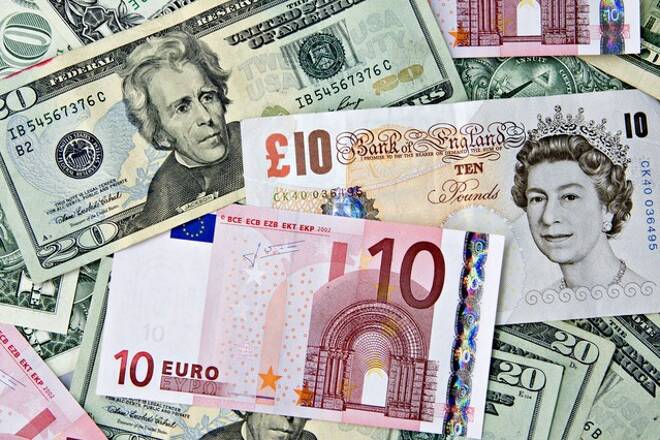Advertisement
Advertisement
The EUR/USD Rebounds as Dollar Profit taking Accelerates
By:
The EUR/USD rebounded sharply on Thursday as investors took profits on the dollar following the recent sharp rally. Softer than expected inflation on the
The EUR/USD rebounded sharply on Thursday as investors took profits on the dollar following the recent sharp rally. Softer than expected inflation on the wholesale and retail levels in the U.S. took some of the luster out of the greenback. The ECB bulletin was cautiously optimistic, while the BoE left interest rates unchanged and provide traders with a dovish outlook.
Technicals
The EUR/USD rebounded sharply back to the January lows near 1.1925 and poised to test resistance near the 10-day moving average at 1.1967. Support is seen near the May lows at 1.1825, and then the December lows at 1.1725. The 10-day moving average recently crossed below the 200-day moving average, which shows that a short-term downtrend is in place. The fast stochastic generated a crossover buy signal in oversold territory which reflects accelerating positive momentum which could foreshadow a correction. The exchange rate will have a difficult time eclipsing the 10-day moving average, but if it does, a squeeze back to 1.22 should be expected.
ECB bulletin remains cautiously optimistic on growth
ECB bulletin remains cautiously optimistic on growth. The editorial stuck pretty much to Draghi’s introductory statement at the last meeting and pretty much confirmed that the ECB remains on course to phase out QE by the end of the year. The text acknowledged that recent data points “towards some moderation” in growth, but stressed that data remained “consistent with a solid and broad based expansion of the euro area economy”, with risks broadly balanced.
Italian production data highlights Easter effect
Italian industrial production came in higher than anticipated, at 1.2% month over month, but the annual rates highlighted the impact of Easter with unadjusted data showing production down -1.1 year over year, versus 2.4% year over year in February, while the working day adjusted measure jumped to 3.6% year over year, versus 2.5% year over year in the previous month. The earlier timing if Easter this year meant holidays started earlier and April numbers are likely to be impacted as well by calendar factors, so we may have to wait for May numbers to get a clearer picture not just in Italy.
The BoE trimmed its 2018 growth forecast keeping Policy Unchanged
The Bank of England Announced Unchanged Monetary Policy. The central bank trimmed its 2018 growth forecast to 1.4% in 2018 from 1.8% projected in February. This was a consequence of the snow-impacted activity in Q1, which saw growth for that quarter come in at just 0.1% quarter over quarter in the preliminary estimate. Expected growth for 2018 and 2019 have been trimmed too, to from 1.8% to 1.7%. The central bank still downplayed the soft patch in growth during Q1, affirming that its central forecast has remained little changed, with GDP expected to grow by around 1.75% per year on average over the forecast period. It noted that growth has continued to rotate towards net trade and business investment and away from consumption, highlighting that strong global demand and accommodative financial conditions have been an offset to Brexit-related uncertainties. Wage growth and cost pressures have been firming gradually, broadly as the BoE expected. The central bank noted that CPI fell to a lower rate than expected in March, of 2.5% year over year, and now expects CPI inflation to fall back slightly more quickly than in forecast in February.
The UK’s total trade deficit narrowed
The UK’s total trade deficit narrowed in Q1 by GBP 0.7 billion to GBP 6.9 billion, driven mostly by a decline in goods imports from non-EU countries. The goods deficit narrowed GBP 1.5 billion with non-EU countries but widened by GBP 0.4 billion with the EU. Excluding erratic commodities, the total trade deficit widened GBP 1.2 billion to GBP 8.5 billion. In the 12 months to March, the total trade deficit narrowed GBP 13.3 billion to GBP 26.6 billion, driven by a 9.2% rise in exports versus a 6.4% rise in imports.
UK March production data came in near expectations
UK March production data came in near expectations, with industrial output rising 0.1% month over month, the same as the month prior, and expanded by 2.9% year over year after 2.1% year over year in February. The respective median forecasts had been for 0.1% month over month and 3.1% year over year. Manufacturing production declined by 0.1% month over month, as expected and round off a sluggish Q1 performance for the sector, while rising by 2.9% year over year. The Office for National Statistics reports that the growth rate of both export and domestic turnover slowed, and that survey-led evidence suggested that the heavy snowfall in March had no significant impact on manufacturing output.
About the Author
David Beckerauthor
David Becker focuses his attention on various consulting and portfolio management activities at Fortuity LLC, where he currently provides oversight for a multimillion-dollar portfolio consisting of commodities, debt, equities, real estate, and more.
Did you find this article useful?
Latest news and analysis
Advertisement
